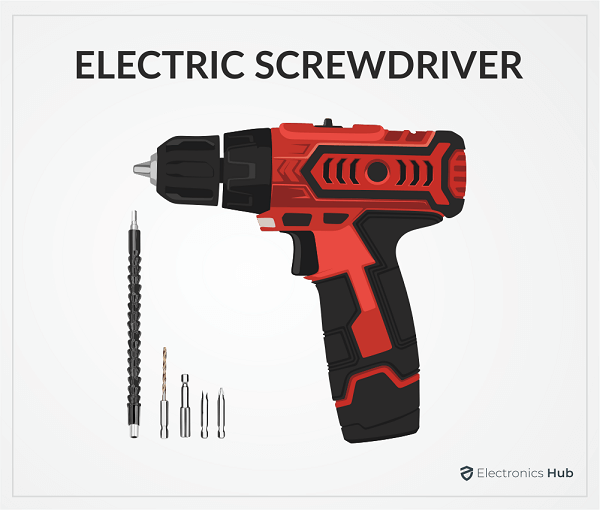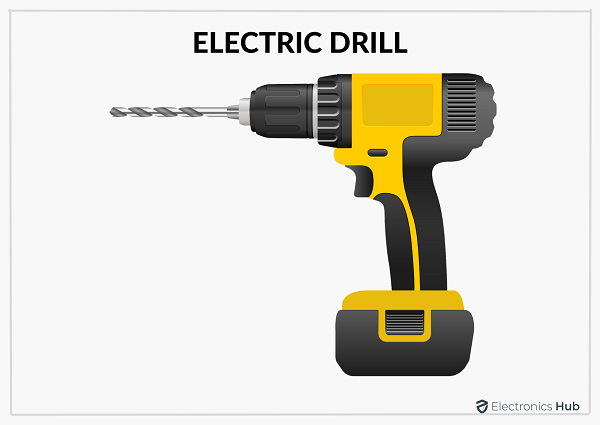Screwdrivers are very simple hand or power tools. You can tighten or loosen fasteners with Screwdrivers. Drills on the other hand, help us to “drill” or bore holes in a variety of materials. Despite their differences in functionality, they look and operate in a very similar way. This often confuses a lot of beginners and new tool buyers. So, we decided to make a simple guide on Electric Screwdriver and Electric Drill. We will see their basics, list the pros and cons. We will also make a side-by-side comparison of Electric Screwdriver vs Drill.
Outline
ToggleA Brief Note on Electric Screwdriver

Slotted or Flat-head and cross-Slot or Phillips are probably the two most popular head types. But there are several other heads such as Torx, Hexagon (Allen), Pozidriv, Square (Robertson), Tri-wing, and several more.
Depending on screw head or the ‘Drive’, we can have different types of Screwdrivers. Irrespective of the type of drive, all screwdrivers perform the same job: screw or unscrew fasteners.
While handheld screwdrivers are still popular, there is a steady growth in the usage of Electric Screwdrivers. The main difference is the instead of manually driving the screws, you can do it easily with the push of a button as it has a motor that runs on electricity.
Another important difference between a handheld or manual screwdriver and an electric screwdriver is that the tip that is in the shape of the drive is replaceable and we call them “Bits”.
So, with a single electric screwdriver, you can easily replace the bit and drive different types of screws or fasteners.
A Brief Note on Electric Drill

The main purpose of these holes is that you can easily insert fasteners, rather than making a hole with them. Using a modern speed-controlled electric drill, you can even fasten screws.
Depending on the surface we want to drill, there are different types of Drill Bits. You have to use Masonry, wood, and Metal Drill Bits on respective surfaces to make a clean hole as well as not damage the bit.
Using an electric drill is very simple. Just insert the correct drill bit into the chuck, place the tip of the bit at the right spot and press the trigger.
Speaking of trigger, almost all modern electric drills have a variable speed mechanism. The speed varies depending the amount of trigger you depress. Also, they have a switch that can make the motor go in clockwise and counter-clockwise directions.
There are two types of electric drills: Mains AC Powered Corded Electric Drills and Battery Powered Cordless Electric Drills. Of the two, the corded electric drills tend to have powerful motors while the cordless drills offer better portability.
Another popular feature of many electric drills is the hammering function. When drilling to tougher objects such as concrete walls, this hammering feature results in a better impact due to the pounding actions.
Pros and Cons
Electric Screwdriver
+ They are smaller tools. You can easily use them in tight spaces to fasten screws.
+ Cordless Electric Screwdrivers have less torque. This means no damage to softer objects.
+ Very easy to use. Even a beginner or an elder can operate an electric screwdriver.
+ The cost of an electric screwdriver kit (Cordless Electric Screwdriver, Battery, Charger, and Bits) is very less. You can get good branded products starting from $20.
– Due to its low power and torque, electric screwdriver is not suitable for making holes.
– As electric drills can fasten screws, the need for a specialty electric screwdriver is becoming rare.
Electric Drill
+ Powerful motor that can make holes in wood, concrete, and metals.
+ Variable speed trigger. Adjust the speed depending on the surface you are working.
+ Due to its speed control mechanism, you can easily use an electric drill as a screwdriver.
+ Hammering actions is important to bore holes in tough objects.
– They are heavy tools.
– Slightly Expensive. The cost of cordless electric drills is even more but they are slowly becoming affordable.
– Must have different types of drill bits for different types of surfaces. This might confuse some beginners.
Comparison of Electric Screwdriver vs Drill
Now that we have seen the basics of Electric Screwdriver and Drill, let us make a side-by-side comparison of the two. The following table compares Electric Screwdriver vs Drill with regards to some important parameters.
| Parameter | Electric Screwdriver | Electric Drill |
| Main Use Case | Tightening and loosening screws | Making holes, fastening screws |
| Power | Low to Medium Power Motor | Very powerful motor |
| Torque | Small torque. But enough to fasten screws. | Very high torque. Can drill holes in wood, metal, and concrete. |
| Bits | Different bits for different drive screws. | Drill Bits for wood, Masonry, and Metal are unique. |
| Additional Features | Variable Speed. | Variable Speed, hammering action, and you can use it as a screwdriver |
| Availability | Cordless Screwdrivers are very common. Corded Electric Screwdrivers are rare. | Both corded and cordless electric drills are popular. |
| Cost | Affordable. | Expensive. |
When to Use Electric Screwdriver vs Drill?
Now it’s the time to choose between Electric Screwdriver vs Drill. Let us begin with the Screwdriver. It is a simple power tool with the sole purpose of fastening screws.
Due to its low power and torque, you cannot use it for any other purpose. Some of you might be tempted to use it as a drill. Don’t.
But most electric screwdrivers have small size, are lightweight and are very easy to use. This makes them suitable for using in tight spaces and even beginners without experience can easily use it.
Coming to the Drill, it is really a power tool. Both Corded and Cordless Electric Drills are significantly powerful than electric screwdrivers. Their torque figures are also high as we often use them to make holes in all sorts of materials.
For tougher objects such as concrete walls, the hammering action is a godsend. It creates additional pounding impact on the surface without much effort from your end.
Also, all electric drills have adjustable speed trigger with reversable motor. This means, you can essentially use an electric drill as a screwdriver.
If you are wondering why we need an electric screwdriver if a drill can do the job of the two, then understand that electric drills, whether corded or cordless, are heavy tools.
Their powerful motor and special hammering mechanism adds a lot of weight. This means, using a drill just for fastening screws is not ideal. But you can use it for occasional tightening or loosening of screws.
If you have a professional workshop or run a serious business, then you need to have both the electric drill as well as the electric screwdriver. But if you are a DIYer or does small household jobs in your home then you have to choose between Electric Screwdriver vs Drill.
Our recommendation is to get a cordless electric drill as it serves you well for making holes as well as fastening screws. Make sure that it has hammering action.
Conclusion
Electric Screwdriver vs Drill is a very popular discussion, especially among first-time tool buyers. They look very similar but have very different power and torque ratings.
In this guide, we saw the basics of Electric Screwdriver and Electric Drill. After that, we listed the pros and cons of both these power tools.
Then, we made a side-by-side comparison of Electric Screwdriver vs Drill. Finally, we saw the answer to the important question, which one should you buy, an electric screwdriver or a drill?

